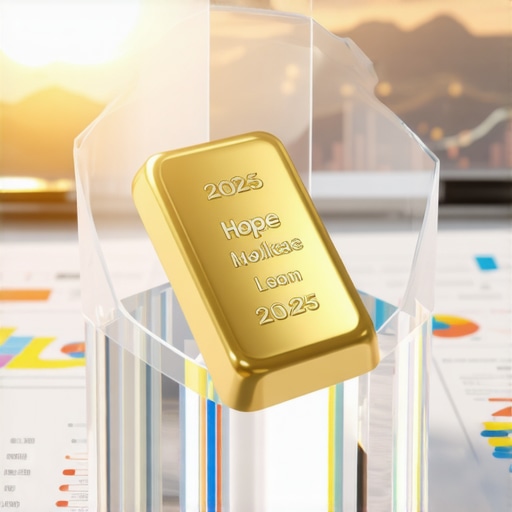Embracing the Golden Paradox: Why 2029 Demands a Balanced Approach to Gold Investing
As global economic complexities mount in 2029, gold remains a timeless beacon for investors seeking stability amid uncertainty. Yet, the challenge lies not merely in owning gold but in crafting strategies that balance its intrinsic rewards against evolving risks. Understanding this nuanced dance is essential for both seasoned investors and newcomers aiming to secure wealth in volatile markets.
Unlocking the Spectrum of Gold Investment Vehicles
Gold investment is far from monolithic. From physical bullion to gold ETFs, mining stocks, and futures, each avenue offers unique risk profiles and return potentials. Physical gold—whether bars or coins—provides tangible security but demands considerations like storage and liquidity. Conversely, financial instruments like gold ETFs and mutual funds offer ease of trading and diversification but expose investors to market volatility and management fees.
For example, gold mining stocks can amplify returns during bullish cycles yet carry operational risks tied to geopolitical and environmental factors. Understanding these dynamics is critical to tailoring your portfolio according to your risk tolerance and investment timeline.
Strategic Allocation: The Art of Diversification Within Your Gold Holdings
Experts recommend allocating gold as a hedge against inflation and currency fluctuations, typically constituting 5-15% of a diversified portfolio. However, in 2029’s shifting landscape, a more nuanced approach involves layering different gold assets to mitigate distinct risks. Combining physical gold for long-term security with selective exposure to gold futures or mining stocks can optimize both liquidity and growth potential.
How Can Investors Balance Gold’s Role as a Safe Haven With Its Market Volatility?
While gold is traditionally viewed as a safe haven, its price can exhibit short-term volatility influenced by factors such as interest rate changes, geopolitical tensions, and shifts in central bank policies. To balance this, investors should adopt disciplined entry and exit strategies, utilize dollar-cost averaging to smooth volatility, and stay informed on macroeconomic indicators. Moreover, leveraging insights from reliable gold price forecasts and supply-demand analyses helps anticipate market swings and adjust positions proactively.
Real-World Wisdom: Learning From Investment Scenarios
Consider a scenario where an investor allocates 10% of their portfolio to physical gold bars, safeguarding assets against inflation, while also holding gold mining stocks to capitalize on operational leverage during market upswings. This hybrid strategy, supported by vigilant market monitoring and diversification, exemplifies how balancing risk and reward can be pragmatically achieved.
For those new to physical gold investments, following expert advice on buying from trusted dealers and understanding storage best practices is crucial to avoid common pitfalls. Resources like physical gold investment tips provide valuable guidance.
If you found these insights valuable, share your thoughts or questions below to join the conversation on mastering gold investments in 2029.
Authoritative Reference: For an in-depth analysis of gold’s role amid economic uncertainty, see the World Gold Council’s report on Gold Demand Trends, which offers comprehensive data and expert insights.
Recognizing the Subtle Risks That Come With Gold Investing
While I’ve always admired gold’s reputation as a reliable store of value, my journey taught me that no investment is without its nuances. One subtle risk I encountered was liquidity—especially with physical gold. Unlike stocks or ETFs that can be sold in seconds, selling gold bars or coins often requires more time and the right buyer. This experience underscored the importance of balancing your portfolio with both liquid and tangible assets.
Moreover, gold prices can be influenced by factors beyond what meets the eye. For instance, as the World Gold Council highlights, central bank purchases and geopolitical events can dramatically sway prices, sometimes creating short-term price spikes or dips that don’t always align with economic fundamentals (Gold Demand Trends).
My Take on Combining Gold With Other Asset Classes
One key lesson I’ve learned is that gold shines brightest when it complements other investments. I diversify by pairing physical gold with selective exposure to gold mining stocks, which often benefit from operational leverage. For example, during market rallies, mining stocks can outperform bullion, adding growth potential to my portfolio.
Additionally, I’ve found that integrating gold ETFs offers a great balance — they provide liquidity and ease of trading without the need for physical storage. This mix helps me remain agile and responsive to market changes.
Have You Considered How Gold’s Role Might Change in Your Investment Strategy Over Time?
This question often comes up when discussing long-term wealth planning. As my financial goals evolve, so does my approach to gold. Early on, I leaned heavily on physical gold for security. Now, I strategically incorporate futures and mining stocks to capture growth while still hedging risks. How about you? Have your views on gold shifted as you gained more experience?
Practical Tips From My Experience for Safe Gold Investing
Buying gold safely is a priority I don’t take lightly. I always recommend purchasing from reputable dealers who provide authenticity guarantees. It’s worth investing time in learning how to verify certificates and understand pricing nuances — resources like the physical gold buying guide have been invaluable in this regard.
Storage is another consideration. I personally use a combination of secure home safes and professional vault services, balancing accessibility with security. It’s a trade-off, but one that safeguards against theft or loss.
If you have stories or questions about your own gold investment journey, please share them in the comments. Engaging with diverse experiences enriches our collective understanding and helps us all navigate this golden landscape more confidently.
Decoding Macroeconomic Indicators: How Global Trends Shape Gold’s Trajectory in 2029
Gold’s price movements are intricately tied to multifaceted macroeconomic variables that extend beyond mere inflation or currency shifts. In 2029, the interplay between interest rate policies, sovereign debt levels, and geopolitical tensions form a complex mosaic influencing gold demand and valuations. For instance, rising interest rates traditionally pressure gold prices due to opportunity costs; however, in environments where inflation outpaces rate hikes, gold often retains its allure as a real asset hedge.
Moreover, central banks’ strategic reserve adjustments—whether accumulating bullion for diversification or selling to meet fiscal needs—can send ripples across the market. Investors must, therefore, cultivate a keen understanding of these macro drivers, leveraging resources such as the World Gold Council’s Gold Demand Trends reports, which provide granular insights into demand dynamics from various sectors including jewelry, technology, and official sector buying.
What Advanced Analytical Tools Can Investors Use to Forecast Gold Price Volatility Accurately?
Predicting gold price volatility requires synthesizing quantitative models and qualitative geopolitical intelligence. Advanced investors utilize econometric models incorporating variables like real interest rates, US dollar index fluctuations, and mining output forecasts. Machine learning algorithms, increasingly popular in financial analytics, can detect subtle patterns and correlations often missed by traditional methods. For example, sentiment analysis from global news feeds and social media trends offers real-time data points that can preempt price shocks triggered by geopolitical upheavals.
Combining technical analysis tools such as Bollinger Bands and Relative Strength Index (RSI) with fundamental macroeconomic indicators refines timing strategies for entry and exit points. The key lies in a multidimensional approach—no single indicator suffices in isolation.
Integrating ESG Considerations Into Gold Investing: The Emerging Frontier
Environmental, social, and governance (ESG) principles are becoming pivotal in gold investing, reflecting a shift towards sustainable finance. Mining operations with robust ESG frameworks often demonstrate better risk management, regulatory compliance, and community relations, which can translate into more stable long-term returns.
Investors increasingly scrutinize mining companies’ environmental footprints, labor practices, and transparency. ESG-focused gold funds have emerged, offering exposure to companies adhering to stringent sustainability standards. This trend not only aligns portfolios with ethical imperatives but may also mitigate risks associated with regulatory penalties or social unrest.
For instance, the Sustainalytics ESG ratings provide comprehensive evaluations of mining companies, enabling investors to differentiate between those leading sustainable practices and laggards.
Mitigating Counterparty and Custodial Risks in Gold ETFs and Futures
While ETFs and futures enhance liquidity and accessibility, they carry nuanced risks often overlooked by retail investors. Counterparty risk—the possibility that the issuer or clearinghouse fails to meet obligations—can affect fund performance or even lead to losses in extreme scenarios. Thorough due diligence on fund structure, custodial arrangements, and regulatory oversight is crucial.
For futures contracts, margin requirements and potential for forced liquidation during volatility spikes necessitate vigilant risk management. Sophisticated investors employ hedging strategies and maintain adequate liquidity buffers to navigate these challenges.
Understanding these intricacies empowers investors to blend physical and paper gold holdings optimally, balancing security, liquidity, and cost efficiency.
If you are ready to deepen your mastery of gold investing strategies tailored for 2029’s complex landscape, explore our advanced resources and expert analyses to elevate your portfolio’s resilience and growth potential.
Unveiling the Impact of Geopolitical Shifts on Gold’s Strategic Value
Amid 2029’s geopolitical turbulence, gold’s role transcends mere asset protection, emerging also as a barometer of global stability. Conflicts, trade realignments, and sanctions can abruptly shift investor sentiment, prompting rapid reallocations into or out of gold holdings. This dynamic demands investors maintain vigilance over international developments and incorporate scenario analyses into portfolio construction to anticipate potential market reverberations.
Quantitative Techniques: Elevating Gold Price Forecasting Beyond Conventional Models
Traditional forecasting methods often fall short in capturing the nuanced interplay between macroeconomic data and investor psychology influencing gold prices. Cutting-edge approaches leverage ensemble machine learning frameworks that integrate time-series data, sentiment indexes, and geopolitical event tagging to produce probabilistic forecasts with enhanced precision. These models facilitate adaptive investment tactics, enabling timely rebalancing aligned with emergent trends and anomalies.
What Are the Best Practices for Incorporating ESG Metrics Into Gold Mining Investment Decisions?
Integrating ESG considerations requires a multifaceted evaluation framework that assesses environmental impact, social responsibility, and governance robustness at both operational and strategic levels. Best practices include utilizing third-party ESG ratings, engaging in active shareholder advocacy, and prioritizing investments in companies demonstrating transparent reporting, reduced carbon footprints, and community engagement initiatives. This approach not only aligns with ethical imperatives but also mitigates regulatory and reputational risks, enhancing long-term shareholder value.
Balancing Custodial Security With Accessibility: Innovations in Gold Storage Solutions
Recent advancements in secure storage technology offer hybrid models combining blockchain-enabled provenance tracking with insured, geographically diversified vaults. These innovations enhance both transparency and asset security, addressing investor concerns over counterparty risk and physical theft. Additionally, emerging decentralized finance (DeFi) platforms provide tokenized gold ownership options, blending liquidity with ownership authenticity, albeit warranting thorough due diligence on platform credibility.

Adopting these technologies requires a careful assessment of trade-offs between control, cost, and convenience, tailored to individual investment mandates and risk appetites.
Strategic Call to Action
To truly master gold investing in 2029’s intricate environment, investors must embrace a holistic, data-driven approach that integrates geopolitical intelligence, advanced analytics, and sustainability criteria. Engage with leading industry research such as the World Gold Council’s Gold Demand Trends and explore emerging technological solutions to refine your investment framework. Join our expert community today to access proprietary tools and insights designed to elevate your portfolio’s resilience and performance.
Frequently Asked Questions (FAQ)
What is the ideal percentage of gold allocation in a diversified portfolio for 2029?
Experts commonly recommend allocating between 5% and 15% of your portfolio to gold as a hedge against inflation and currency risks. However, in 2029’s complex economic environment, layering different gold assets—such as physical bullion, ETFs, and mining stocks—can optimize risk management and growth potential. Tailoring allocation depends on individual risk tolerance, investment horizon, and market outlook.
How does physical gold compare to gold ETFs and mining stocks in terms of risk and liquidity?
Physical gold offers tangible ownership and security but tends to have lower liquidity and higher storage costs. Gold ETFs and mutual funds provide greater liquidity and ease of trading but expose investors to counterparty and management risks. Mining stocks can amplify returns during bullish cycles but carry operational and geopolitical risks. A balanced portfolio often combines these vehicles to harness their complementary benefits.
What macroeconomic factors most influence gold prices in 2029?
Key drivers include interest rate policies, inflation rates, currency fluctuations, central bank reserve activities, and geopolitical tensions. For instance, rising real interest rates can dampen gold’s appeal due to opportunity costs, but persistent inflation or geopolitical instability tends to elevate demand. Staying informed on these indicators, using authoritative reports and advanced analytics, is crucial for strategic positioning.
How can ESG criteria be effectively integrated into gold investing?
Integrating ESG requires evaluating mining companies on environmental impact, social responsibility, and governance practices through third-party ratings such as Sustainalytics. Investors should prioritize companies with transparent reporting, sustainable operations, and strong community engagement to mitigate regulatory and reputational risks while aligning with ethical standards and supporting long-term value creation.
What risks should investors be aware of when using gold futures and ETFs?
Gold futures and ETFs involve counterparty risk, margin requirements, and potential forced liquidations during market volatility. Investors must understand fund structures, custodial arrangements, and maintain liquidity buffers. Proper due diligence and risk management strategies, including hedging and diversification, help mitigate these exposures.
How do geopolitical developments impact gold’s strategic value?
Geopolitical shifts—such as conflicts, trade realignments, and sanctions—can rapidly alter investor sentiment and gold demand. Gold often acts as a safe haven during global instability, leading to price spikes. Incorporating scenario analyses and monitoring international events enables investors to anticipate and respond proactively to such dynamics.
Are there advanced tools available to forecast gold price volatility more accurately?
Yes, sophisticated investors use econometric models, machine learning algorithms, sentiment analysis, and technical indicators like Bollinger Bands and RSI. These tools integrate quantitative data and geopolitical intelligence to produce probabilistic forecasts, improving timing and risk management in volatile markets.
What are the best practices for safe physical gold storage?
Combining secure home safes with insured, geographically diversified vaults is recommended to balance accessibility and security. Innovations such as blockchain-enabled provenance tracking enhance transparency and reduce counterparty risk. Evaluating trade-offs between cost, control, and convenience ensures storage aligns with investment objectives.
Can integrating gold with other asset classes improve portfolio resilience?
Absolutely. Gold complements equities, bonds, and alternative investments by providing diversification and a hedge against inflation and currency risks. Combining physical gold with selective exposure to mining stocks and ETFs can enhance both stability and growth potential, adapting as financial goals evolve.
How should new investors approach buying physical gold to avoid scams and overpaying?
Purchasing from reputable dealers who provide authenticity guarantees is essential. Learning to verify certificates and understand pricing nuances helps avoid common pitfalls. Utilizing comprehensive buying guides and expert resources fosters informed decisions and protects capital.
Trusted External Sources
- World Gold Council (WGC): As the leading authority on gold market data and research, WGC’s Gold Demand Trends reports offer granular insights into global gold supply, demand, and investment patterns, essential for understanding macroeconomic impacts.
- Sustainalytics ESG Ratings: This specialized provider delivers comprehensive evaluations of environmental, social, and governance factors for mining companies, enabling investors to assess sustainability risks and opportunities effectively.
- International Monetary Fund (IMF): The IMF offers valuable macroeconomic data and analyses on global financial stability, interest rate trends, and currency movements that influence gold prices and investment strategies.
- London Bullion Market Association (LBMA): LBMA sets industry standards for gold trading and storage, providing authoritative information on market integrity, clearing mechanisms, and custodial best practices.
- Financial Times and Bloomberg: These respected financial news organizations provide timely geopolitical and economic developments, along with expert commentary and technical analysis tools critical for real-time gold market intelligence.
Conclusion
In 2029’s multifaceted economic landscape, mastering gold investing demands a sophisticated, balanced approach that integrates diverse investment vehicles, macroeconomic awareness, ESG principles, and advanced analytical tools. Gold remains a vital component of portfolio diversification—serving as both a hedge against uncertainty and a potential growth asset when complemented with mining stocks and ETFs. Navigating risks such as liquidity challenges, counterparty exposures, and geopolitical volatility requires vigilance, education, and strategic flexibility.
By leveraging authoritative resources like the World Gold Council and Sustainalytics, applying quantitative forecasting techniques, and embracing innovations in storage and market access, investors can enhance portfolio resilience and capitalize on gold’s enduring value. Whether you are a novice or an expert, continuous learning and adaptive strategies are key to unlocking gold’s full potential.
Engage with this content by sharing your perspectives, asking questions, or exploring our comprehensive expert analyses to elevate your gold investment decisions in 2029 and beyond.









